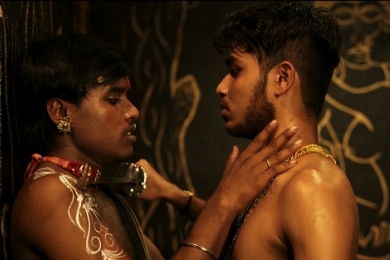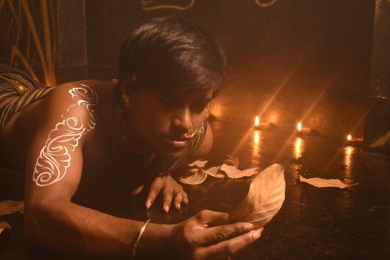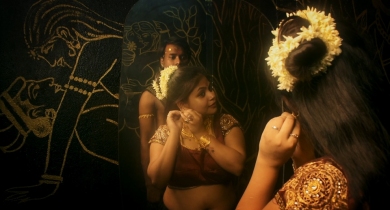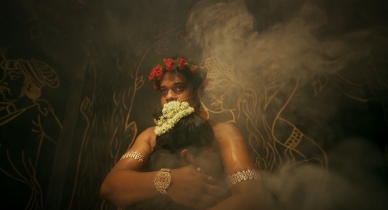
|   |

|   |
 e-mail: ukb7@rediffmail.com Breaking gender barriers Photos courtesy: Santoshpur Anuchintan July 9, 2021 Ancient Greeks apparently knew that the humans had, other than male and female genders, some deviations too. The Roman poet Ovid - in recording Greek mythology at the turn of the millennium -- noted that Hermaphroditus, son of Hermes and Aphrodite (Venus and Mercury), was a remarkably handsome youth, seeing whom bathing in a pool, a water nymph fell in love and prayed that they might never be separated. The gods interpreted her request literally and joined the pair into one body! Hermaphroditus became a bi-sexual entity and represented androgyny (effeminacy) long portrayed in Greco-Roman art as a female figure with male organs. The Mother Nature has similar phenomena occurring not so rarely among her diverse flora and fauna. When flowers of a plant have both male and female structures, i.e., both stamens and carpels, they are termed androgynous and hermaphroditic. Among animals, platypus is semi-aquatic and egg-laying, yet a mammal endemic to eastern Australia including Tasmania. The same-sex courtship or conjugal behaviour occur over a short period of time in cockroaches and rams, while long term pair bonding between same-sex partners (comprising courtship, conjugal and parental activities) has been documented in over 450 species of animals worldwide! In humans, conditions that involve discrepancies between external organs and internal reproductive organs are described by the term "intersex". In the relatively rare conditions of true hermaphroditism, an individual has both ovarian and testicular tissues. But there are also cases of pseudo-hermaphrodites among human females and human males (due to different genetic patterns within their body). In such "false intersex" cases, females have male external genitalia and are brought up as males, but eventually they develop breasts and menstruate. (In contrast, males in parallel genetic cases are born with female external genitalia and may be brought up as females, but they possess reproductive organs of a male!). All this is not to be confused with "sexual orientation" where sexuality can be an enduring pattern of emotional and romantic attractions to people of the same sex, as in homosexuality. Normal hetero-sexuality, along with intersexuality and homosexuality of the above kind, are the three main categories of sexual orientation among humans. It may seem complex, but that is life!  The first meeting of Chitrangada with Arjuna  Chitrangada looks at autumn leaves as Arjuna walks away Chitrangada: The story of a Hermaphrodite, presented by 'Santoshpur Anuchintan' took the bull by the horns and considered the whole question of human sexuality in a highly imaginative format of dance choreography, mimetic action, music and painting. Conceived and directed by the avant-garde young director Gaurav Das, the performance was accepted in the 'Learn Togetherness: Beyond Binaries' Art Festival, organized jointly by Kolkata Centre for Creativity, British Council India and the gender related NGO 'Sappho for Equality', for streaming from June 21 to 27 on the KCC YouTube channel. The performance followed very closely Tagore's prose-play -and later changed by him into dance drama - Chitrangada, where he took from the epic Mahabharata, the intriguing tale of the Manipuri princess brought up by her father as a boy and taught warfare. In all probability, this was a case of "false intersex" (also known as "pseudo-hermaphroditism") where the "boy" was not aware of "his" female identity until "he" met the Pandava warrior Arjuna doing penance in a forest. With her latent femininity aroused now, she offered herself to Arjuna, only to be scoffed at by the hero as a playful male urchin. Mortally offended, she offered ardent prayers to the love-god Madana to turn her into a well adorned female. Madana agreed and in the present performance, employed two assistants to teach her love play as from Vatsyayana's Kama Shastra, with assistance from Madana's consort Rati. Well equipped now, the "new female" Chitrangada approached Arjuna to have very fulfilling erotic nights. But, in the process, she had fitful thoughts in having duped herself out of her lifelong vocation of weaponry and warfare, and returned to Madana: urging him to restore her former self. Back in her original unadorned identity of a "male", she was accepted gladly by Arjuna. The on-line production employed slow paced mimed choreography, mainly supported by narration and music. To create the erotic ambience, the backdrop made copious use of two pieces of Khajuraho temple's popular sculptures as panoramic paintings. The first was a male lying supine in a Brahminical posture and an eager female leaning over for union, much reminiscent of the love goddess Venus seeking to "mount" the handsome shepherd boy Adonis in Shakespeare's classic long poem, Venus and Adonis. The other painting was of the queen sitting on the king's lap in a conjugal position. The paintings were beautifully done, but the non-verbal dramatic action and choreographic prowess of the dramatis personae might not pass muster under strict aesthetical norms. This does not disqualify the highly indigenous and courageous attempt to bring the gender issue - highly skewed against anyone outside the mainstream hetero-sexual genus - which remained the principal aim. Additionally, the characters were apparently drawn from the underprivileged class, which made it a doubly laudable effort. Kudos to the young director for having made the very bold artistic experiment!  Chitrangada in her newly attained female avatar  Madana blesses Chitrangada Interview with the director Dr. Gaurav Das: How was your production of Chitrangada different from the common run of Tagore's? Most of the prevalent interpretations of Tagore focus on the social bigotry faced by the people of the third gender and the amount of humiliation they have to bear with, that's all. What set our production apart was that, more than the social acceptance, it was the self-realization of gender plurality within herself by Chitrangada which we wanted to celebrate, which we also felt was the real essence of Tagore's play. In order to understand this feminine energy within the male body, we took help of the Baul tradition, where all male sadhakas recognized the importance of understanding the Prakritibhava (feminine energy) within themselves to attain the state of nirgunapurush (formless man). According to Baul tradition, the only man (purush) was the nirgunapurush, the rest all were prakriti (female)! Hence, in our performance, Chitrangada took a journey to attain the nirgunapurush (formless man's state) as she underwent humongous physiological changes. The performance also deeply reflected on the biological changes of the character of Chitrangada whereby her character was seen dealing with the changes in her outer manifestations both physiologically and psychologically. In our interpretation, Madana or Kamadeva had assumed the role of a sex educator who imparted his disciples with the knowledge to lead a healthy life with fulfillment of desires. Since, the primary aspect of Chitrangada's physiological change was also associated with her desire to be sexually wanted and accepted by Arjuna, she must first acquire the knowledge of love and desire from Madana before her biological transformation into full femininity. The production also depicted the sexual conflicts in Arjuna whereby he first rejected the masculine form of Chitrangada, but engages in a game of lust with her feminine form later, only to crave eventually for the masculine Chitrangada. The sexual conflicts within Arjuna deeply exposed his deep-rooted patriarchal conditioning, the hypocrisies and prejudices of our society. So, we could say that while Chitrangada might be an individual's quest for freedom, our production echoed and resonated the voices of a very large number of lost souls all looking for an identity. You have also restructured your performance using Kamasutra, the ancient sex treatise by Vatsyayana... Yes, we used Kamasutra as a reference to highlight the sexual politics underlying our text. In our interpretation, Madana or Kamadeva assumed the role of a sex educator who imparts his disciples with the knowledge to lead a healthy life with passion and yearnings. The aspect of Chitrangada's physiological change was also associated with her desire to be sexually wanted and accepted by Arjuna; she must first acquire the knowledge from Kamasutra from Madana before she biologically transformed into a woman. In the production, you used separately male and female actors to depict Chitrangada, why? I used two separate bodies of opposite gender to convey the message that even though the body transits, the soul remains the same and thereby brings all its previous attributes with it. Moreover, this was done to retain the magical realism already inherent in Tagore's text whereby Madana transforms Chitrangada from one form to another. Because the text is so rooted in sexuality, I felt if I wanted to do justice to this text, I had to go beyond Tagore's text and hence I started exploring sexuality in our ancient scriptures. So, I took help of Kamasutra and transformed Madana into a sex educator. How did you visualize the unusual dramatic space? I knew I wanted to tell the story in a constricted space, most probably a space with cave-like features whereby forbidden desires could bloom and forlorn lovers could re-unite. So, we built this dark room where the walls were painted with figures from our mythology or history that celebrates sexuality. The set was designed to resemble a place where lovers had met for thousands of years and celebrated their love and passion for each other! While using Tagore's play, you seem to have completely abandoned his music... I knew from the beginning that I wanted to retain the essence of Tagore's text ,but not make it yet another staging of his traditionally performed dance drama. Hence the decision to completely abandon not only songs from Tagore's dance drama, but any of his songs in general. So, looking at the era we were representing, we naturally progressed to Hindustani classical music with lyrics in mostly Awadhi dialect to tell our story. We used raga Sindhu Bhairavi to express both the compassion (karunam) and sorrow (shokam) when Chitrangada met Arjuna for the first time and was rejected. The colourful romance between Chitrangada (her femme fatale avatar) and Arjuna has been picturized using the romantic and soothing raga Manjh Khamaj, while for their separation we have composed a tune in Mishra Jaunpuri which creates deep pathos and solemn mood in the minds of the listeners. Towards the end when the production took a more philosophical turn, I deliberately switched to traditional folk songs highlighting the Baul Philosophy. Finally, could you comment on your choice of costume and jewellery? The costumes and the jewellery were also designed keeping the period in mind. Here also the aspect of fluidity was built as the men in this production were seen adorned with nose rings. Chitrangada for me was a production that celebrated those individuals who dared to live a life beyond the binaries and believed in a more inclusive society with a place for everyone!  Dr. Utpal K Banerjee is a scholar-commentator on performing arts over last four decades. He has authored 23 books on Indian art and culture, and 10 on Tagore studies. He served IGNCA as National Project Director, was a Tagore Research Scholar and is recipient of Padma Shri. Comments * I am reaching out to you as there is needed a small intervention about a recent article published on Narthaki using a derogatory/ stigmatizing word for intersex community and not sure whom to flag this up with hence dropping a note. This is indeed a wonderfully written and articulated article. However there is a little concern on the word Hermaphrodite. As per my knowledge, this is an old and derogatory word used for intersex and non binary people. Majorly a bio/medical word used for insects and animals that have more than two genders but doesn’t apply for humans. This word is used as a cuss / slur word for intersex/trans/enby identities and usually triggers a lot of trans disporia in people. Here are some references to the above point which I found on the internet. isna.org/ lgbtq.unc.edu/ edi.nih.gov/ Is there any way we can replace this word with the word "Intersex"? Please do let me know if you have any questions. Thanks and regards Patruni Chidananda Sastry (July 11, 2021)
Post your comments Pl provide your name and email id along with your comment. All appropriate comments posted with name and email id in the blog will also be featured in the site. |